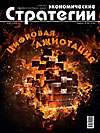Network Revolution
Keywords:
,
,
,
,
,
,
,
,
The article analyzes phenomenon of overall spreading of networks structures in the modern post-industrial society, called the network revolution. Namely network structures based on voluntary co-operation and partnership are becoming the most efficient form of organizing social communities in today’s highly competitive and dynamic social environments. They have advantages over previously prevailing hierarchical structures, as pooling of resources, knowledge and spiritual efforts of people in the network structures provides synergistic effect.
References:
- Castells M. Stanovlenie obshchestva setevykh struktur [Formation of a Network Society]. Novaya postindustrial’naya volna na Zapade. Antologiya [New Post-Industrial Wave in the West. Anthology]. Pod redaktsiey V.L. Inozemtseva. Moscow, 1999, pp. 494–505.
- Oleskin A.V. Setevye struktury v biosistemakh i chelovecheskom sotsiume [Network Structures in Biosystems and Human Society]. Moscow, URSS, 2012.
- Oleskin A.V. Setevoe obshchestvo: Neobkhodimost’ i vozmozhnye strategii postroeniya. Setevaya (retikulyarnaya) sotsial’no-ekonomicheskaya formatsiya: kvazisotsialisticheskie printsipy i meritokratiya [Network Society: Necessity and Possible Strategies for its Building. Network (Reticular) Socio-Economic Formation: Quasi-Socialist Principles and Meritocracy]. Moscow, LENAND, 2016.
- Abramov R. Setevye struktury i formirovanie innovatsionnogo obshchestva [Network Structures and Formation of an Innovative Society]. Setevoy proekt “Russkogo Mira”, available at: http://www.archipelag.ru/geoeconomics/soobshestva/power-identity/network-structure/
- Akulov V.B., Rudakov M.N. Teoriya organizatsii [Theory of Organization]. Petrozavodsk: PetrGU, 2002.
- Asaul A.N., Voynarenko M.P., Erofeev P.Yu. Organizatsiya predprinimatel’skoy deyatel’nosti [Business Activities Organization]. Saint Petersburg, Gumanistika, 2004.
- Barinov V.A., Zhmurov D.A. Razvitie setevykh formirovaniy v innovatsionnoy ekonomike [Networked Units Development in the Innovation Economy]. Menedzhment v Rossii i za rubezhom, 2007, no. 1, available at: яttp://www.dis.ru/library/561/25924/
- Bol’shakov A.V. Genezis i struktura delovykh setey v kontekste teorii postindustrial’noy ekonomiki [Genesis and Business Networks Structure in the Context of Post-Industrial Economics Theory]. Ekonomicheskiy analiz: teoriya i praktika, 2012, no. 10 (265), pp. 35–40.
- Katenev V.I. Perspektivy razvitiya setevoy ekonomiki v usloviyakh formiruyushchegosya obshchestva znaniy [Prospects of the Networked Economy Development in Conditions of Emerging Knowledge Society]. Problemy sovremennoy ekonomiki, 2007, no. 2 (22), available at: http://www.m-economy.ru/art.php?nArtId=1353.
- Weinzweig P. Desyat’ zapovedey tvorcheskoy lichnosti [Ten Commandments of a Creative Personality]. Moscow, Progress, 1990, p. 66.
- Interesnye fakty o sotsial’nykh setyakh [Interesting Facts About Social Networks]. 2014, available at: http://dusha7.blogspot.com/2014/01/blogpost5146.html; https://vk.com/page-4617_44598538;http://www.seoded.ru/istoriya/interesnii-fakti.html.
- Lukin N., Musienko A.V. Model’ setevogo terrorizma Mishelya Zanini [Model of Network Terrorism by Michele Zanini]. Teoreticheskiy zhurnal “Credo”, 2007, available at: http://credonew.ru/content/view/624/59/
- Knyazeva E.N., Kurkina E.S. Myslitel’ epokhi mezhdistsiplinarnosti [Thinker in the Era of Interdisciplinarity]. Voprosy filosofii, 2009, no. 9, pp. 116–131.
- Kurkina E.S., Knyazeva E.N., Kuretova E.D. Tsiklicheskaya dinamika razvitiya Mir-Sistemy [Cyclic Dynamics of the World System Development]. Slozhnye sistemy, 2013, no. 3 (8), pp. 4–50.
- Kapitsa S.P. Demograficheskaya revolyutsiya, global’naya bezopasnost’ i budushchee chelovechestva [Demographic Revolution, Global Security and the Future of Mankind]. Budushchee Rossii v zerkale sinergetiki [The Future of Russia in the Mirror of Synergetics]. Moscow, KomKniga, 2006, pp. 238–254.



